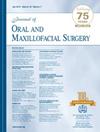Is Abobotulinum A Superior to Onabotulinum A in Reducing Pain in Patients With Nocturnal Bruxism?
IF 2.3
3区 医学
Q2 DENTISTRY, ORAL SURGERY & MEDICINE
引用次数: 0
Abstract
Background
Botulinum toxin has been used to treat myofascial pain and nocturnal bruxism. It remains unclear whether there is a difference in efficacy between different BTX subtypes.
Purpose
The purpose of this study was to measure the changes in pain and maximum incisal opening in subjects with nocturnal bruxism who received either Abobotulinum A (ABA) or Onabotulinum A (OBA) and determine which is faster and longer-acting.
Study Design, Setting, Sample
The researchers implemented a retrospective cohort study. Subjects presenting to Uzman Dentaclinic outpatient clinic in Bursa, Turkey, with nocturnal bruxism between June 2023 and June 2024 were identified from a review of the electronic medical record. Subjects with systemic diseases, taking active medications and undergoing psychotherapy were excluded from the study.
Predictor Variable
The predictor variable was the treatment assigned to the subjects received either ABA or OBA injections.
Main Outcome Variable(s)
The primary outcome variable is therapeutic response as evidenced by changes in preoperative and postoperative pain score and maximum mouth opening. The secondary outcomes were the time to onset and duration of therapeutic response.
Covariates
The covariates included demographics (age, sex) and preoperative (duration of complaint) variables. The postoperative covariates were postinjection discomforts and complications.
Analyses
χ2 tests were used to analyze categorical data. Unpaired t-tests, Friedman test and Mann–Whitney U test were used to analyze continuous data. Results were considered significant at a P value of <.05.
Results
The sample included 100 subjects with a mean age of 35.32 ± 9.11 years (OBA group, 33.78 ± 8.36 years; ABA group, 36.86 ± 9.64 years) (P = .09). There were 8 men (16%) and 42 women (84%) in the OBA group, and 10 men (20%) and 40 women (80%) in the ABA group (P = .6). There were no statistically significant differences between the groups in terms of visual analog scale scores and maximum mouth opening values at 2 weeks, 1 month, 3 months, 4 months, and 6 months (P ˃ .05). The ABA and OBA groups showed statistically significant differences in the onset of the treatment effect (11.18 ± 2.93 days [95% CI: 10.36 to 11.99] vs 8.69 ± 2.7 days [95% CI: 7.94 to 9.44]; P ˂ .05) and its duration (5.11 ± 1.19 months [95% CI: 4.78 to 5.43] vs 7.14 ± 1.71 months [95% CI: 6.66–7.61]; P ˂ .05).
Conclusions
The ABA group demonstrated an earlier onset and longer duration of the treatment effect. However, both types of BTX-A products, which are commonly used in dental clinics, provided statistically significant outcomes in terms of pain and maximum mouth opening.
肉毒杆菌A在减轻夜间磨牙患者疼痛方面是否优于肉毒杆菌A ?
背景:肉毒杆菌毒素已被用于治疗肌筋膜疼痛和夜间磨牙。目前尚不清楚不同BTX亚型之间是否存在疗效差异。目的:本研究的目的是测量夜间磨牙症患者接受肉毒杆菌A (ABA)或肉毒杆菌A (OBA)治疗后疼痛和最大切口开口的变化,并确定哪一种更快、更持久。研究设计、环境、样本:研究人员采用回顾性队列研究。在2023年6月至2024年6月期间,通过对电子病历的审查确定了在土耳其布尔萨的Uzman dentacclinic门诊就诊的夜间磨牙患者。患有全身性疾病、正在服用积极药物和正在接受心理治疗的受试者被排除在研究之外。预测变量:预测变量是分配给受试者接受ABA或OBA注射的治疗。主要结果变量:主要结果变量是治疗反应,由术前和术后疼痛评分和最大开口变化证明。次要结果是发病时间和治疗反应持续时间。协变量:协变量包括人口统计学(年龄、性别)和术前(投诉持续时间)变量。术后协变量为注射后不适和并发症。分析:采用χ2检验对分类资料进行分析。采用非配对t检验、Friedman检验和Mann-Whitney U检验对连续数据进行分析。结果:样本共纳入100例受试者,平均年龄35.32±9.11岁(OBA组,33.78±8.36岁;ABA组,36.86±9.64岁)(P = 0.09)。ABA组男性8例(16%),女性42例(84%),ABA组男性10例(20%),女性40例(80%)(P = .6)。两组患者2周、1个月、3个月、4个月、6个月的视觉模拟量表评分和MMO值比较,差异均无统计学意义(P < 0.05)。ABA组和OBA组在治疗效果的开始时间上差异有统计学意义(11.18±2.93天[95% CI: 10.36 ~ 11.99] vs 8.69±2.7天[95% CI: 7.94 ~ 9.44];P小于0.05)及其持续时间(5.11±1.19个月[95% CI: 4.78 ~ 5.43] vs 7.14±1.71个月[95% CI: 6.66 ~ 7.61];P小于0.05)。结论:ABA组起效早,治疗效果持续时间长。然而,在牙科诊所中常用的两种类型的BTX-A产品在疼痛和最大开口方面提供了统计上显著的结果。
本文章由计算机程序翻译,如有差异,请以英文原文为准。
求助全文
约1分钟内获得全文
求助全文
来源期刊

Journal of Oral and Maxillofacial Surgery
医学-牙科与口腔外科
CiteScore
4.00
自引率
5.30%
发文量
0
审稿时长
41 days
期刊介绍:
This monthly journal offers comprehensive coverage of new techniques, important developments and innovative ideas in oral and maxillofacial surgery. Practice-applicable articles help develop the methods used to handle dentoalveolar surgery, facial injuries and deformities, TMJ disorders, oral cancer, jaw reconstruction, anesthesia and analgesia. The journal also includes specifics on new instruments and diagnostic equipment and modern therapeutic drugs and devices. Journal of Oral and Maxillofacial Surgery is recommended for first or priority subscription by the Dental Section of the Medical Library Association.
 求助内容:
求助内容: 应助结果提醒方式:
应助结果提醒方式:


